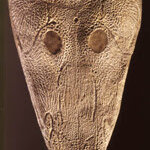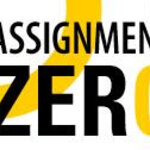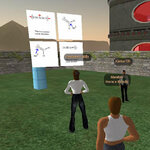Science category landing
Physical Sciences

The beautiful thing about the Antarctic is that it is one of Earth’s last unexplored frontiers. New information about climate, geology, and paleontology is discovered regularly and today, the Journal of Vertebrate Paleontology announced the discovery of a fossilised amphibian which lived more than 245 million years ago in the Triassic of Antarctica. Its presence suggests that the climate at the time was mild enough to allow cold-blooded creatures to live near Pangea’s southern margin, at least seasonally.
This news is of particular relevance to my work so I was very excited when I heard…

Joanna Scott just wrote a nice little review of what is going on at Nature Island (slurl) on Nature's Nascent blog since her return from the American Chemical Society meeting in Chicago.
The Blue Obelisk Cemetery, where I give my students quiz races on Fridays was featured (only possible through help from Beth and Eloise - thanks again!). Another fun place is Mary Anne Clark's biological cell that you can enter and float amongst the mitochondria.
Nature Island has really become a very interesting place to hang out, meet smart people and learn and share.

Fans of Open Source Science (or just the open source concept in general) should take a look at Assignment Zero. Jay Rosen writes on the About page:
Inspired by the open-source movement, this is an attempt to bring journalists together with people in the public who can help cover a story. It's a collaboration among NewAssignment.Net, Wired, and those who choose to participate.
The investigation takes place in the open, not behind newsroom walls. Participation is voluntary; contributors are welcome from across the Web. The people getting, telling and vetting the story are a mix of professional…

This study examined whether a traditional low-impact mind–body exercise, Tai Chi, affects health-related quality-of-life (HRQOL) and headache impact in an adult population suffering from tension-type headaches.
According to the National Headache Foundation, more than 45 million Americans suffer from chronic headaches, with losses of $50 billion a year to absenteeism and medical expenses and an excess of $4 billion spent on over-the-counter medications.
Tension-type headaches (TTH), which represent approximately 78% of all headaches, occur either in single episodes or chronically, and are…

As I mentioned earlier, we were interested in getting our compounds screened by the Developmental Therapeutics Program (DTP) at the National Cancer Institute. The first entry is now done and from what I understand it will be 8-10 business days before we get a request for the compound after they check for uniqueness.
This is good timing because it really is time to gather up all of the isolated and characterized compounds in UsefulChem on one page, which is now linked on the left navigation bar on the wiki. This page should also be used by other people interested in screening who want to…

The periodic table of elements, all 111 of them, just got a little competition. A new discovery by a University of Missouri-Columbia research team, published in Angewandte Chemie, the journal of the German Society of Chemists, allows scientists to manipulate a molecule discovered 50 years ago in such as way as to give the molecule metal-like properties, creating a new, "pseudo" element. The pseudo-metal properties can be adjusted for a wide range of uses and might change the way scientists think about attacking disease or even building electronics.
Five decades ago, Fred Hawthorne,…

We just ran a quiz race in Second Life for the second time yesterday in my organic chemistry class. Two of the students were physically with me in the classroom and two were coming in remotely.
Initially, Beth was still the owner of the obelisks and we learned the hard way that all but one stop working when the owner is not on the island. We worked it out this morning by transferring the ownership to me and as long as I was next to my students all of them could do the quizzes.
Beth is always talking about the community spirit in Second Life and I got a taste of it first hand when Beth…

Research by Renee Theiss, Jason Kuo and C J Heckman, which has just been published in The Journal of Physiology, throws light on how information is processed in the Central Nervous System (CNS) to drive movement. The findings are relevant to understanding mechanisms underlying movement and disorders such as spinal cord injury and motor neurone disease (ALS).
Interneurones in the spinal cord integrate command signals from the brain, with information from the senses, and their own internal pattern generating activities to send appropriate instructions to motorneurones controlling movement.…

Too much of a good thing (nutrients or water) actually decreases the diversity of species in an ecosystem while it increases the productivity of a few species, according to a grassland experiment conducted by University of Minnesota researchers.
The reduction in species diversity occurs because increasing the amounts of limiting resources, such as nitrogen and water, makes an ecosystem more homogeneous and consequently reduces the number of opportunities for competing species to coexist. Put another way, it reduces the number of niches, allowing a few species to dominate.
The study,…

Electrical noise, like the crackle heard on AM radio when lightning strikes nearby, is a nuisance that wreaks havoc on electronic devices. But within cells, a similar kind of biochemical "noise" is beneficial, helping cells transform from one state to another, according to a new study led by a UT Southwestern Medical Center researcher.
Dr. Gürol Süel, assistant professor of pharmacology, said his research and that of his colleagues published today in the journal Science represents "a new paradigm," suggesting that rather than being bad for biology, cellular noise might have an important…